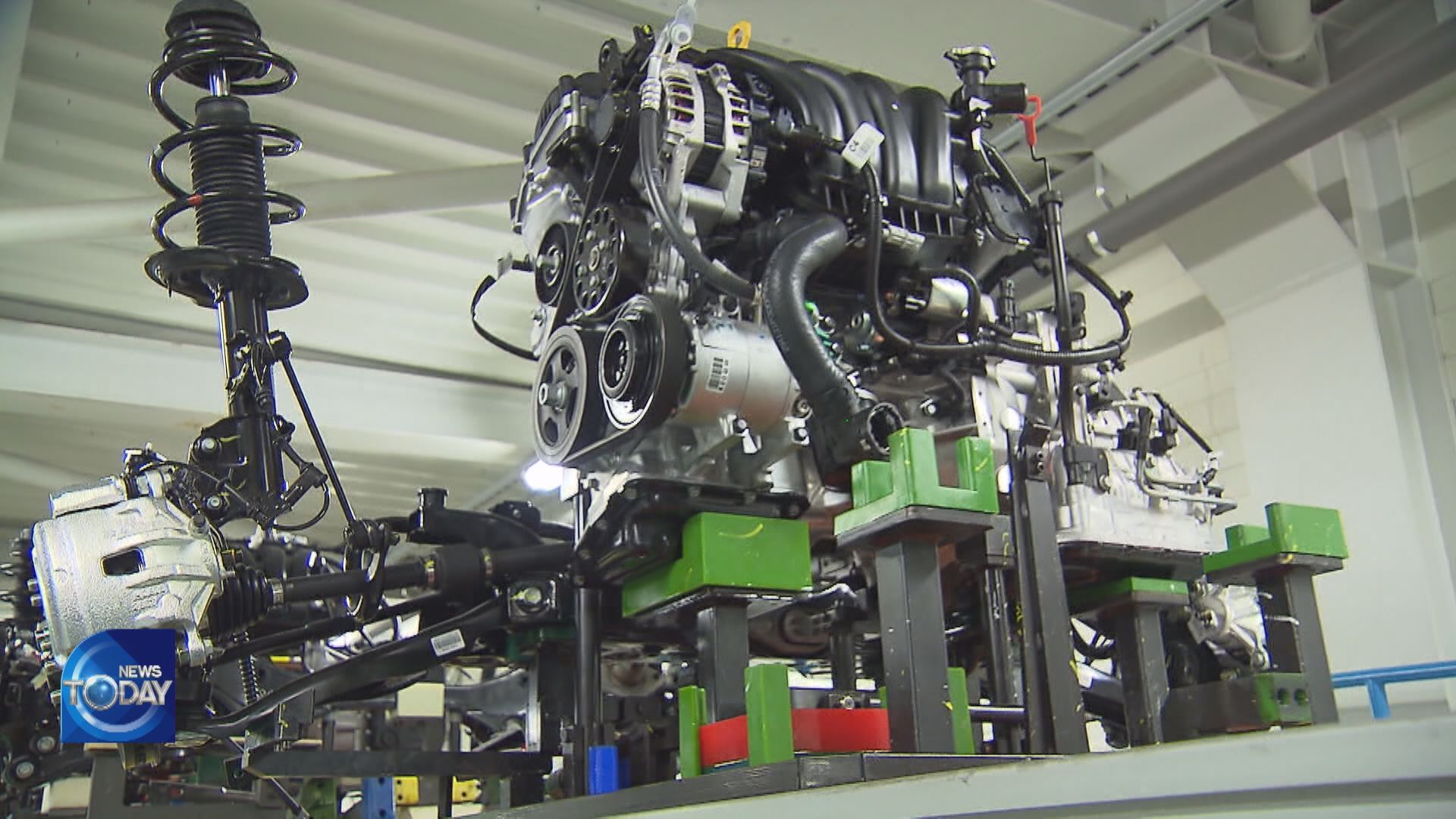GAINS AND LOSSES FROM FTA AGREEMENT
입력 2022.03.16 (15:05)
수정 2022.03.16 (16:45)
읽어주기 기능은 크롬기반의
브라우저에서만 사용하실 수 있습니다.
[Anchor Lead]
Yesterday was the 10th anniversary of the enactment of the KORUS free trade agreement. Korea reaped much benefit from the trade deal, such as nearly doubling the trade surplus. However, there are many issues in other sectors, like an increased import of American beef causing the decline of small Korean beef producers. Here’s a look at Korea’s gains and losses from the FTA.
[Pkg]
This factory manufactures pistons for automotive engines. About 20% of the total output is exported to the US. Their export has increased more than eight fold since the signing of the KORUS FTA and subsequent removal of the import duty.
[Soundbite] Yang Jun-gyu(CEO, Automotive Parts Manufacturer) : "Tariffs are set at only a few percent, but even that can be very taxing. We benefited from the tariff removal and close relations between the two countries."
Korea’s automotive parts industry is one of the sectors that benefited from the FTA. Car exports to the U.S. grew at an average of 7% annually after a 2.5% tariff on automobiles and parts was removed. As a result, automobiles and automotive components account for 25% of Korea’s export to the U.S. More noticeably, the export of electric vehicles has nearly tripled every year, spurred on by America's environment-friendly policies. Secondary batteries and synthetic resin exporters also saw their annual growth rates average between 15 to 20%. On the other hand, the import of American crude oil and gas increased dramatically from almost zero. The import of American beef, which Korean farmers had protested strongly against, recorded an average increase of about 13% per year. In the process, the number of small cattle farmers fell more than 40% over the past ten years.
[Soundbite] Lee Jeong-hun(Council for Livestock Related Groups) : "The livestock self-sufficiency rate halved and the number of livestock farmers plummeted. They urgently need assistance ahead of the 2026 zero-tariff plan and soaring fodder costs."
However, some experts say the livestock industry has been reshaped as the number of large cattle farmers that raise more than 50 cows has actually risen.
Yesterday was the 10th anniversary of the enactment of the KORUS free trade agreement. Korea reaped much benefit from the trade deal, such as nearly doubling the trade surplus. However, there are many issues in other sectors, like an increased import of American beef causing the decline of small Korean beef producers. Here’s a look at Korea’s gains and losses from the FTA.
[Pkg]
This factory manufactures pistons for automotive engines. About 20% of the total output is exported to the US. Their export has increased more than eight fold since the signing of the KORUS FTA and subsequent removal of the import duty.
[Soundbite] Yang Jun-gyu(CEO, Automotive Parts Manufacturer) : "Tariffs are set at only a few percent, but even that can be very taxing. We benefited from the tariff removal and close relations between the two countries."
Korea’s automotive parts industry is one of the sectors that benefited from the FTA. Car exports to the U.S. grew at an average of 7% annually after a 2.5% tariff on automobiles and parts was removed. As a result, automobiles and automotive components account for 25% of Korea’s export to the U.S. More noticeably, the export of electric vehicles has nearly tripled every year, spurred on by America's environment-friendly policies. Secondary batteries and synthetic resin exporters also saw their annual growth rates average between 15 to 20%. On the other hand, the import of American crude oil and gas increased dramatically from almost zero. The import of American beef, which Korean farmers had protested strongly against, recorded an average increase of about 13% per year. In the process, the number of small cattle farmers fell more than 40% over the past ten years.
[Soundbite] Lee Jeong-hun(Council for Livestock Related Groups) : "The livestock self-sufficiency rate halved and the number of livestock farmers plummeted. They urgently need assistance ahead of the 2026 zero-tariff plan and soaring fodder costs."
However, some experts say the livestock industry has been reshaped as the number of large cattle farmers that raise more than 50 cows has actually risen.
■ 제보하기
▷ 카카오톡 : 'KBS제보' 검색, 채널 추가
▷ 전화 : 02-781-1234, 4444
▷ 이메일 : kbs1234@kbs.co.kr
▷ 유튜브, 네이버, 카카오에서도 KBS뉴스를 구독해주세요!
- GAINS AND LOSSES FROM FTA AGREEMENT
-
- 입력 2022-03-16 15:05:56
- 수정2022-03-16 16:45:45

[Anchor Lead]
Yesterday was the 10th anniversary of the enactment of the KORUS free trade agreement. Korea reaped much benefit from the trade deal, such as nearly doubling the trade surplus. However, there are many issues in other sectors, like an increased import of American beef causing the decline of small Korean beef producers. Here’s a look at Korea’s gains and losses from the FTA.
[Pkg]
This factory manufactures pistons for automotive engines. About 20% of the total output is exported to the US. Their export has increased more than eight fold since the signing of the KORUS FTA and subsequent removal of the import duty.
[Soundbite] Yang Jun-gyu(CEO, Automotive Parts Manufacturer) : "Tariffs are set at only a few percent, but even that can be very taxing. We benefited from the tariff removal and close relations between the two countries."
Korea’s automotive parts industry is one of the sectors that benefited from the FTA. Car exports to the U.S. grew at an average of 7% annually after a 2.5% tariff on automobiles and parts was removed. As a result, automobiles and automotive components account for 25% of Korea’s export to the U.S. More noticeably, the export of electric vehicles has nearly tripled every year, spurred on by America's environment-friendly policies. Secondary batteries and synthetic resin exporters also saw their annual growth rates average between 15 to 20%. On the other hand, the import of American crude oil and gas increased dramatically from almost zero. The import of American beef, which Korean farmers had protested strongly against, recorded an average increase of about 13% per year. In the process, the number of small cattle farmers fell more than 40% over the past ten years.
[Soundbite] Lee Jeong-hun(Council for Livestock Related Groups) : "The livestock self-sufficiency rate halved and the number of livestock farmers plummeted. They urgently need assistance ahead of the 2026 zero-tariff plan and soaring fodder costs."
However, some experts say the livestock industry has been reshaped as the number of large cattle farmers that raise more than 50 cows has actually risen.
Yesterday was the 10th anniversary of the enactment of the KORUS free trade agreement. Korea reaped much benefit from the trade deal, such as nearly doubling the trade surplus. However, there are many issues in other sectors, like an increased import of American beef causing the decline of small Korean beef producers. Here’s a look at Korea’s gains and losses from the FTA.
[Pkg]
This factory manufactures pistons for automotive engines. About 20% of the total output is exported to the US. Their export has increased more than eight fold since the signing of the KORUS FTA and subsequent removal of the import duty.
[Soundbite] Yang Jun-gyu(CEO, Automotive Parts Manufacturer) : "Tariffs are set at only a few percent, but even that can be very taxing. We benefited from the tariff removal and close relations between the two countries."
Korea’s automotive parts industry is one of the sectors that benefited from the FTA. Car exports to the U.S. grew at an average of 7% annually after a 2.5% tariff on automobiles and parts was removed. As a result, automobiles and automotive components account for 25% of Korea’s export to the U.S. More noticeably, the export of electric vehicles has nearly tripled every year, spurred on by America's environment-friendly policies. Secondary batteries and synthetic resin exporters also saw their annual growth rates average between 15 to 20%. On the other hand, the import of American crude oil and gas increased dramatically from almost zero. The import of American beef, which Korean farmers had protested strongly against, recorded an average increase of about 13% per year. In the process, the number of small cattle farmers fell more than 40% over the past ten years.
[Soundbite] Lee Jeong-hun(Council for Livestock Related Groups) : "The livestock self-sufficiency rate halved and the number of livestock farmers plummeted. They urgently need assistance ahead of the 2026 zero-tariff plan and soaring fodder costs."
However, some experts say the livestock industry has been reshaped as the number of large cattle farmers that raise more than 50 cows has actually risen.
이 기사가 좋으셨다면
-
좋아요
0
-
응원해요
0
-
후속 원해요
0














![[단독] 골프연습장 아니라더니<br>…‘한남동 골프연습장’ 도면 입수](/data/news/2025/07/01/20250701_Uh8Jnu.png)


이 기사에 대한 의견을 남겨주세요.